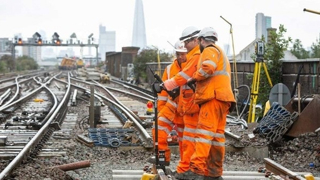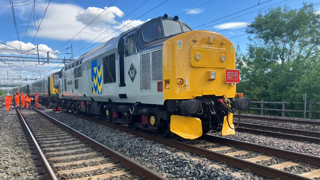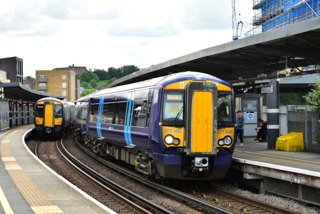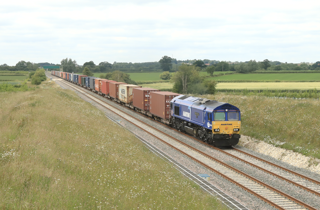Christian Wolmar on what the £100m bat tunnel says about the nature of the HS2 project
 Only by looking at the origins of the HS2 project can we understand how we got to £100 million bat tunnels that may prove to have been totally unnecessary.
Only by looking at the origins of the HS2 project can we understand how we got to £100 million bat tunnels that may prove to have been totally unnecessary.
Christian Wolmar on what the £100m bat tunnel says about the nature of the HS2 project
 Only by looking at the origins of the HS2 project can we understand how we got to £100 million bat tunnels that may prove to have been totally unnecessary.
Only by looking at the origins of the HS2 project can we understand how we got to £100 million bat tunnels that may prove to have been totally unnecessary.
The HS2 project started out as a vision - a scheme that would unlock the potential of the railways for the 21st century.
Ignoring the fact that the idea of a high-speed line had been clearly rejected by the 2006 Eddington Report into the role of transport in stimulating economic growth, the idea was resuscitated by Andrew Adonis, who arrived as a junior transport minister soon afterwards and later took over the top role at the Department for Transport.
Adonis was not only a massive enthusiast for high-speed rail, he was also a man in a hurry, aware that the 2010 General Election might cut short his ambitions.
Therefore, by the time of the election, remarkably quick decisions had been made about the route and the method of delivering the project - which would be through HS2 Ltd, a wholly owned government company.
Network Rail, which produced alternative ideas for the scheme, was in effect sidelined, as the organisation was perceived as old school and therefore not open to the brave new world of high-speed rail.
HS2 Ltd was to be given free rein to make decisions, untroubled by anything as mundane as a budget, and fettered only by six-monthly reports to Transport Secretaries who were preoccupied by more immediate matters (such as getting the trains to run on time and filling in potholes) to worry about the odd-billion or two overspend on a project for which they would never get the chance to cut the ribbon.
HS2 Ltd was soon beyond the reach of government control. It went on its merry way, merely telling the government at the end of the year what it cost.
Without a set budget, it allocates contracts on a cost plus basis, essentially giving contractors an open cheque book. Its minutes are a disgrace, with so many redactions (and consequently black patches) that I can’t print them off on my computer because the printer runs out of ink. As Andrew Gilligan wrote in The Sunday Times, just before the bat tunnel story kicked off: “HS2 and Department for Transport officials concealed the rising costs from Parliament… they misled No. 10 and at least one Treasury official. They ousted staff who rang alarm bells.”
Moreover, the figures on costs are always expressed in 2019 prices.
Nor have the project’s travails been helped by plans for a 400kph (248mph) line, faster than any other in the world, requiring bespoke trains and engineering, a straight alignment, and all sorts of other expensive features such as specifying a 120-year life for assets.
Just to compound all this, the project was reviewed during the premiership of Boris Johnson, who loves grands projets and therefore was not open to any sensible value for money assessment of the scheme. Instead, Johnson spoke about how it would be the “fastest and best railway” in the world.
So, that’s how we get to £100m bat tunnels. This is, in fact, not a new story and therefore does not result from a last-minute change in specification.
The possible need for ‘bat mitigation’ in the Sheephouse Wood area in Buckinghamshire has been known right from the passage of the bill in 2015. No fewer than 17 options were considered by HS2 Ltd, and all but the tunnel were ultimately rejected.
They ranged from a mesh screen along either side of the railway (cheaper but not compliant, why?) to a bored tunnel or lowering the track (both of which would have cost even more of a fortune).
In fact, the £100m is an underestimate. The cost as expressed in 2019 prices now comes to £115.8m (£145m in today’s money), consisting of £29.8m to reinforce groundworks to “accommodate a superstructure” (perhaps an engineer could explain to me why reinforcing a half-mile stretch of land to enable the fitting of a relatively light structure costs nigh on £30m) and the cost of the structure itself (a cool £85m).
I had a bit of a spat with the HS2 press team, as I came across a board document which said the cost of bat mitigation measures at the site “cost £203.1m”, which was more than double the original sum mentioned.
I was about to cite this figure in this column and on my podcast, but when I tweeted it out, the press team said this was wrong as it was the total cost of work on this section of line.
I protested that this did not make sense, but then they sent me detailed figures showing that this included £75m for “the baseline solution with no superstructure”, and that the accountants had simply bunched all the figures into one.
Although I accepted the press team’s argument, I must say this demonstrates something much more important - the casual nature with which HS2 Ltd bandies about figures involving tens or hundreds of millions of pounds with little regard for their accuracy.
This is yet another reason why the project has been out of control for so long. And a senior source intimated to me that this was just the tip of a large iceberg.
The inclusion of a bat tunnel (it’s technically a cover rather than a tunnel) was the result of concern over the environmental effect on the species.
Gareth Dennis, an occasional RAIL contributor and a strong advocate of HS2, went on the radio to defend the cost after tweeting that “£100m for a complex 1km-long structure is really good value”.
Sorry, but you can build two secondary schools with 1,500 pupils each for that amount, and that would be money well spent.
He then went on the radio defending the scheme, saying it only represented less than 0.1% of the total cost of the whole project. This is at the heart of what is wrong with the project - the idea that it is worth doing at any price.
The key point missed by Dennis and the environmentalists is proportionality. Even the NHS recognises that it can’t spend an infinite amount of money on squeezing out every day of life for every patient. It therefore rations through concepts such as QALY (quality adjusted life years) that can be expected if a procedure is undertaken - determined by NICE (the National Institute for Health Care and Excellence), which makes decisions about whether prescribing particular drugs is worthwhile.
Where is the similar process for the environmental effects of HS2?
The answer is: there is none. No one ever took up the issue of the bat tunnel and put forward a well-argued paper about the benefits and costs of the scheme.
Yes, there were some 17 different proposals put forward for mitigation, and apparently the tunnel came out as the best option.
Maybe that was the right choice, but then no one took up that proposal and said: “Minister [or indeed chief executive], it’s going to cost more than £100m to put up this tunnel and there are only 300 bats [of the rare type], and we don’t even know the extent to which they will be affected. What shall we do?”
But this clearly never happened.
This is only one, rather extreme, example of the problems faced by the environmental effects of the scheme. Was building a ten-mile tunnel through the Chilterns (not exactly the Alps), along with another 25 miles along the rest of the route, in addition to numerous viaducts and bridges, assessed in relation to the potential damage they might cause? Or were they simply accepted as necessary in the face of opposition from local residents and environmentalists, without a proper analysis?
I suspect the answer is all too obvious.
In a way, Dennis’s defence of the indefensible is the reason why HS2 is in this mess. Its advocates never took a step back and tried to answer the question which I and others have attempted to pose: at what point does the project become simply too expensive to be worthwhile?
And the corollary of that would have been: “And how does HS2 try to reduce costs and limit future ones?”
Perhaps, too, it might have helped if the scheme had started with a clear figure for what it would cost, rather than the vague estimates which have been wrenched out of HS2 Ltd with great difficulty.
Where, for example, is an up-to-date business case reflecting 2024 realities about passenger numbers, in the wake of the working from home phenomenon and the massively increased costs? I reckon they would be lucky to achieve a benefit:cost ratio of 0.5 - in other words, a 50p return for every pound spent.
There is a final irony to this story. This section of line was actually an old railway route - no less than the Great Central Main Line, with trains running at 100mph, belching steam and not (presumably) disturbing bats.
So, as HS2 Ltd Chair Sir Jon Thompson has noted, quite possibly not a single bat would have been affected.
The bat story was indeed initiated by Thompson, when he mentioned the story at the Railway Industry Association conference on November 7 to highlight the difficulties which the scheme faces - not least the 8,000+ documents he mentioned that were needed to deal with this bat tunnel.
Inevitably, the media picked this up. But also, it made the whole HS2 overspending story comprehensible.
It is difficult for the public to relate to stories of billions of pounds overspending, but this explained the whole story in simple terms.
There will undoubtedly be plenty of similar tales of woe for this benighted project, and each one will make it more difficult for those who have to decide whether to stick or twist on Britain’s largest ever infrastructure scheme.
Login to continue reading
Or register with RAIL to keep up-to-date with the latest news, insight and opinion.

















Stuart - 27/11/2024 16:16
It's more a reflection of why any infrastructure work costs so much and takes so long in this country. So costs a lot. And doesn't seem to elsewhere in Europe. Too much time on environmental surveys, archaelogical surveys, DEI etc.